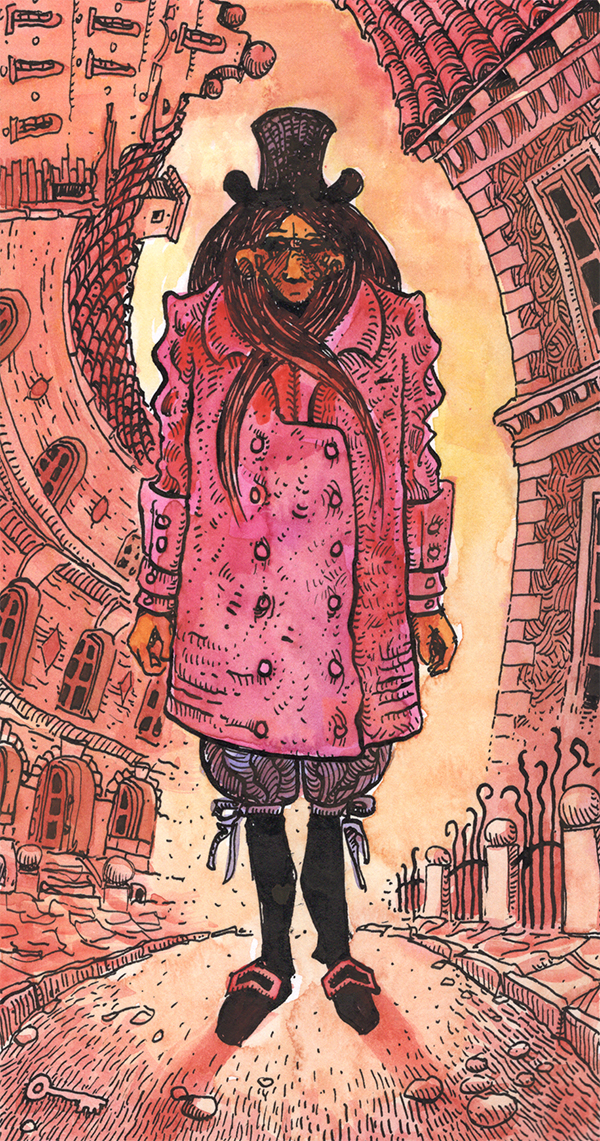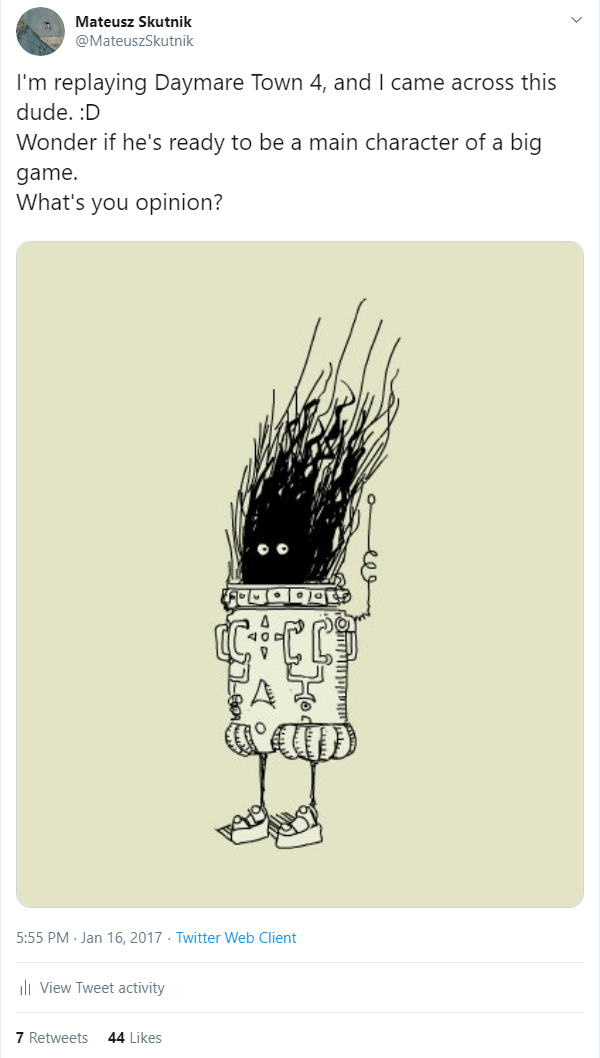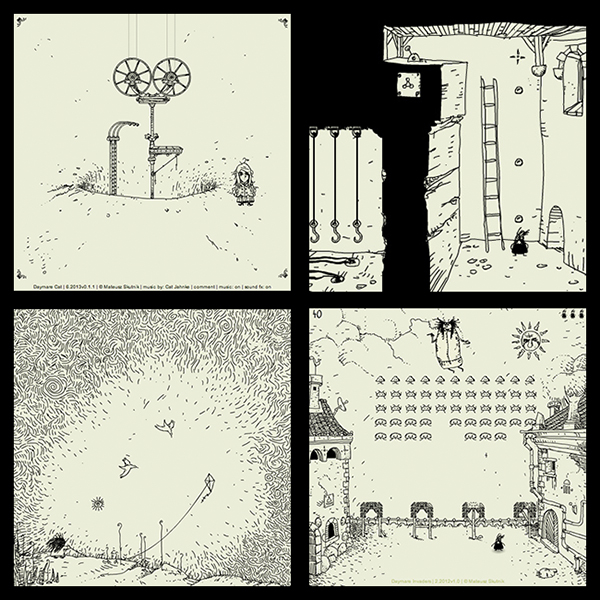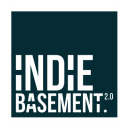Patreon Reward • Daymare Town
September 24, 2019


I’m replaying Daymare Town 4, and I came across this dude. :D
Wonder if he’s ready to be a main character of a big game.
What’s you opinion? pic.twitter.com/AXsWL9OZja— Mateusz Skutnik (@MateuszSkutnik) January 16, 2017

A word of explanation.
As a preparation for inevitable Daymare Bundle, which will consist of everything dmt-related, I thought it would be a good idea to put together this mini bundle for those who already purchased Daymare Towns 1 through 4. These games are too small for me to shamelessly ask for any money for them separately, but after combining them into one, cozy, small mini bundle, I think they’re worth the price of admission. So – feel free to expand your Daymare collection, and if you’re still waiting for the whole thing to be released in one package – that’s coming up soon. Just hold on.
[sale discontinued after release of DMT Bundle]
– What first sparked your interest in making your own games?
There came a moment when my computer skills grew sufficient enough to comprehend the then-emerging game building software for noobs and not-really-programmers, meaning – me. The year was 2001 and the software was ‘the Games Factory’. Though it had it’s limitations, I was able to create my first platformers using my own graphics (strangely enough – it was graphics from my comic book “the Morfs” which resemble Daymare Town. So even back then I was kinda going in the right direction). Of course things got a bit more advanced once I was introduced to the Macromedia Flash software. That was in 2003. Still hooked on platform games I discovered website lazylaces.com which was a hub for escape games, unfortunately it’s no longer active. After playing some of those games I thought: “Wait. I can do this better”. And I created Submachine. The rest is history.
– Is making games now your full-time job?
Yes. It’s been this way since 2008, so for more than half of a decade I’m doing nothing but my games to put food on my table. Best half of decade ever.
– Are you autodidact or did you follow art education? Are there other games or game designers that you feel have strongly influenced you?
The closest I got to actual artistic education was studying architecture on technical university. That actually gave me the ability to look at game design from a slightly different perspective. That’s why I call myself games architect. Other than that – no, I never attended any artistic school nor taken any classes or courses. However it took me 15 years to finally learn how to draw so that it doesn’t look like crap. I already knew how to tell comic book stories by then, so it clicked nicely.
– If you had to name one of your games you’re most proud of, which one would it be and why?
I think that would be Submachine 2. It was the largest leap in my game dev advancement. Of course, each game that came after that was more complex and better, but this one marks that moment when my abilities just blew up. My eyes opened back then.
– Do you have an entire series planned out before you create your first chapter or do you continually expand a series?
No, of course not. That would actually be pointless and kind of stupid. You see, when you create a series, new ideas pop up in your head from time to time, and planning ahead would mean disregarding those ideas. We’d loose a big chunk of content and storyline this way. I create my games the same way I create my comic books. Often I start the story and don’t know where I’ll end up with it. Good example would be Daymare Town 4. Through out almost entire development I had a different ending in mind. But the game evolved is such direction that I found a new ending, the one that;s better suited for the situation we were currently in. Normally a player doesn’t see that, but each game is jumping through countless parallel universes, where in each the storyline takes a different turn. My job is to float with it and steer the story in the right direction.
– What was the inspiration for the Submachine series? Would you love to design actual machines?
The works of Amanita (Samorost mainly), Wada Che Nanahiro (Memory Park, Treasure Box, TCB Museum), also Crimson room, Viridian Room and MOTAS. All of them I learned through lazylaces.com. Those were masterful works, I never imagined competing with them. But besides those there were loads of poorly designed and drawn games – that’s where I stepped in. The actual machines? No, I don’t think so. My thing is drawing and telling stories really. Not creating installation art.
– Is submachine 10 going to wrap everything up or is it just going to leave us with more questions?
The tenth Submachine wraps up the main storyline. Which is – us following Murtaugh and Liz through time, space and dimensions. Will it explain everything? I doubt that. That’s almost impossible. If it was to explain all questions then it would be a book, not a game. And that’s why I leave door open for possible submachine standalone games after finishing the main run. Those standalone games would try to answer some burning questions left out from the final game.
– What prompted you to choose the two-color design for the Daymare Town series of games? Is the design process for these games very different/faster than your full color games?
The main idea for the Daymare game was this: how about a game that’s so damn hard – no one will be able to say it’s too easy. How about making it in sketches only. By then I also already knew Nanahiro’s work, and Daymare is kind of derivative from his Treasure Box. Is it faster? No, not at all. On the contrary – when making a color drawing I can just fill some spaces with color and not bother with them anymore, while here – I have to render each surface, each nook and cranny with just lines, shadowing, pores, structure and so on. It’s actually harder and takes longer than, let’s say, creating a submachine view.
– Will we ever see something photography inspired like the 10 gnomes series again? Do you do a lot of photography?
Well, 10 Gnomes are not dead. It’s an ongoing series, since the main project ended in 2008, I’m creating one additional game yearly. Not sure if I’ll be able to keep it up, but for now – it’s going well. Do I do a lot of photography? I don’t think so. Right now everyone with a smartphone is a photographer. It’s nothing uncommon. I am not a photographer, I’m just a dude with a camera.
– Are you planning to bring your games to mobile? Is it helpful when we buy the HD versions of your games?
The mobile market is very unpleasant and unforgiving. When you’re not backed by a large promotional campaign, you’re toast. We learned that the hard way when Pastel Games went mobile in 2008 and in less than a year went belly-up. But – we might try again, this time with a better plan. I can’t really talk about this, but something is brewing. As for HD games – those have literally nothing to do with mobile versions. Buying HD versions is very helpful though. Thanks to those purchases I’m able to live, feed my family and work in peace not bothered by some additional work that I’d have to do for somebody else for profit. I’m self-sustaining entity and that’s something very important to me. The creative freedom that comes with it is priceless. Big THANK YOU goes out to everyone who bought a game from me. Or a comic book. That’s also possible, you know.
– Can we expect more Pastel Games from other artists or are you mainly concentrating on your own games now?
Well, that’s a good question, but addressed to a wrong person. You’d have to ask the creators of respective series. We’re not pushing anybody to work with us and we don’t actually manage those people. Once they do something and it lands on my desk for me to program – then I do it and the game is out. It was always like this, lately those people probably have something more important to do. From what I’ve heard, the Fog Fall 5 is in the works (and has been for the last two years, so there).
– Are you playing a lot of games yourself (web/console/mobile)? What recent games did you enjoy?
Not really. I don’t have a time. Especially since the beginning of 2014 was jam-packed with work (Submachine 9, new comic book, now JayisGames game). I didn’t play anything since January and that saddens me. I have a backlog of games waiting in line for me to play them. They’re even installed on steam, just waiting, updating from time to time…. This line includes second season of the Walking Dead, Metro: Last Light, Hard Reset and lately I added Transistor… The only exception is “the Child of light” – I’m playing that with my daughter in co-op on our PS3.
– What can we expect from you in the (near) future?
In the near future – let’s talk the remainder of 2014. You can expect the entire Submachine series in HD, as well as Daymare Town in HD. That’s plan A. Besides that – probably new Gnomes game and for sure Where is 2015. Besides that – another update to the Submachine Universe (reaching for the 100th location). Comic book wise – I just released a book, but I’ll be making another one this summer. It should be out in October. That’s another book from my Revolutions comic book series. This time it’s entitled “Revolutions under the snow”. That’s all I can say for now. So, busy spring, busy summer and busy autumn. I’ll rest in the winter. No biggie…
by: Bart Bonte
 Końcówka była hardcorowa. Tak zażartej walki o miejsca w finałowej 15-tce nie spodziewał się żaden z jurorów. O wygranej jednych i przegranej drugich zaważyły setne i dziesiętne! Ostatnie godziny głosowania na zgłoszone do konkursu Indie Basement 2.0 gry to walka nerwów w gronie twórców oraz spory stres i rozterki wśród członków międzynarodowego jury. Dominik Głowacki i przewodniczący zespołu sędziowskiego Johannes Wadin nie mieli łatwego zadania, bowiem w wyścigu o dwa miejsca w finale prześcigały się nieustannie cztery idące łeb w łeb produkcje. Po wielu analizach, TOP 15 konkursu Indie Basement 2.0 przybrało ostateczną formę:
Końcówka była hardcorowa. Tak zażartej walki o miejsca w finałowej 15-tce nie spodziewał się żaden z jurorów. O wygranej jednych i przegranej drugich zaważyły setne i dziesiętne! Ostatnie godziny głosowania na zgłoszone do konkursu Indie Basement 2.0 gry to walka nerwów w gronie twórców oraz spory stres i rozterki wśród członków międzynarodowego jury. Dominik Głowacki i przewodniczący zespołu sędziowskiego Johannes Wadin nie mieli łatwego zadania, bowiem w wyścigu o dwa miejsca w finale prześcigały się nieustannie cztery idące łeb w łeb produkcje. Po wielu analizach, TOP 15 konkursu Indie Basement 2.0 przybrało ostateczną formę:
Kolejność najlepszych gier konkursu Indie Basement 2.0 jest alfabetyczna. Już niebawem ujawnimy nominacje w poszczególnych kategoriach. Twórcy finałowych gier zawalczą o następujące nagrody: licencję UNITY PRO, polską i angielską lokalizację gry ufundowaną przez mocap.pl, pakiet wartości 1500zł na udźwiękowienie swojej produkcji od firmy SoundIT, tablety Pentagram Quadra 7 Ultra Slim oraz słuchawki Plantronics. Jeśli chcesz poznać zwycięzców, którym nasza redakcja ufunduje pamiątkową statuetkę i dyplomy, przyjedź na retro imprezę Pixel Heaven 2014 do Warszawy już 31 maja 1 czerwca! To właśnie tam odbędzie się wystawa gier i uroczysta ceremonia wręczenia nagród z udziałem 1ndie World i jurorów!
—- u p d a t e —-
W zeszłym tygodniu po długich naradach wyłoniliśmy wreszcie finałową 15-tkę największego w Polsce konkursu dla twórców niezależnych Indie Basement 2.0. Dziś mamy dla Was kolejną istotną informację – jury wybrało nominacje w kategoriach. Ogłoszoną w materiałach promocyjnych kategorię Fresh Air zastąpiła kategoria Best Art. Już 1 czerwca w Warszawie podczas Pixel Heaven 2014 odbędzie się uroczysta ceremonia wręczenia nagród z udziałem jurorów, redakcji 1ndie World, organizatorów eventu Dominika Głowackiego i Roberta Łapińskiego oraz sponsorów. Wówczas też dowiemy się, która z finałowych gier wygrała nagrodę Grand Prix i miano najlepszej gry konkursu Indie Basement 2.0! Poniżej znajdziecie nominacje: #BEST GAMEPLAY
#BEST ART
#BEST SOUND
#BEST STORY
Wszystkim finalistom redakcja 1ndie World życzy powodzenia!
Why play it?
The Daymare Town series is instantly recognizable due to Mateusz Skutnik’s sketchy artstyle. Skutnik makes particularly good use of heavy lines to add presence to the darker corners of the eponymous town, suggesting a sinister belly lies just underneath the sunny disposition. He’s especially talented in giving tangibility to the hard textures of architecture. It gives the buildings a life and history of their own — a blank wall is never just that — which is very important as you’ll be staring at them a lot.
Throughout each of the games is an unsettingly quietness, as if something is watching you, and doing its best to keep out-of-sight. That said, sometimes you will meet the inhabitants of the town and soon wish you hadn’t. They’re fond of staring, moving around behind your back, and working against your intentions. But who can blame them? It’s you who has walked in on their turf during their personal time.
The Daymare Town series is worth playing for the eerie ambiance and peculiar architecture that you’re left to fumble with; finding hidden passages, mechanisms, notes stuffed in holes. I particularly love learning how the strange, esoteric objects you find connect with the environment, or their significance to their owners.
There are some rough spots where a solution to a puzzle isn’t as obvious as it should be, but that’s easy to glean over due to the coalescence of art, puzzles, and mystery.
Chris Priestman